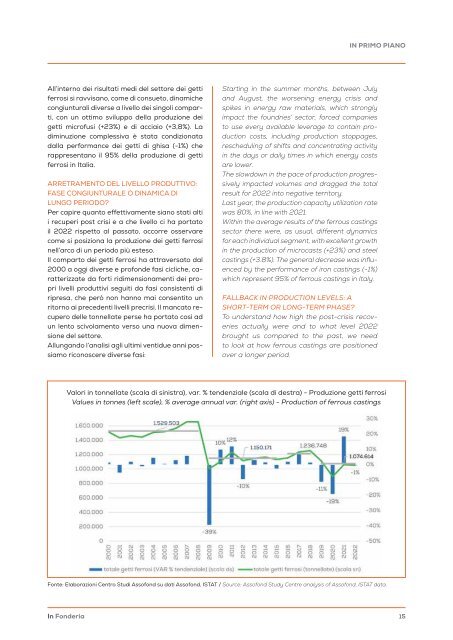In Fonderia 3 2023
Terzo numero del 2023 di In Fonderia
Terzo numero del 2023 di In Fonderia
You also want an ePaper? Increase the reach of your titles
YUMPU automatically turns print PDFs into web optimized ePapers that Google loves.
IN PRIMO PIANO<br />
All’interno dei risultati medi del settore dei getti<br />
ferrosi si ravvisano, come di consueto, dinamiche<br />
congiunturali diverse a livello dei singoli comparti,<br />
con un ottimo sviluppo della produzione dei<br />
getti microfusi (+23%) e di acciaio (+3,8%). La<br />
diminuzione complessiva è stata condizionata<br />
dalla performance dei getti di ghisa (-1%) che<br />
rappresentano il 95% della produzione di getti<br />
ferrosi in Italia.<br />
ARRETRAMENTO DEL LIVELLO PRODUTTIVO:<br />
FASE CONGIUNTURALE O DINAMICA DI<br />
LUNGO PERIODO?<br />
Per capire quanto effettivamente siano stati alti<br />
i recuperi post crisi e a che livello ci ha portato<br />
il 2022 rispetto al passato, occorre osservare<br />
come si posiziona la produzione dei getti ferrosi<br />
nell’arco di un periodo più esteso.<br />
Il comparto dei getti ferrosi ha attraversato dal<br />
2000 a oggi diverse e profonde fasi cicliche, caratterizzate<br />
da forti ridimensionamenti dei propri<br />
livelli produttivi seguiti da fasi consistenti di<br />
ripresa, che però non hanno mai consentito un<br />
ritorno ai precedenti livelli precrisi. Il mancato recupero<br />
delle tonnellate perse ha portato così ad<br />
un lento scivolamento verso una nuova dimensione<br />
del settore.<br />
Allungando l’analisi agli ultimi ventidue anni possiamo<br />
riconoscere diverse fasi:<br />
Starting in the summer months, between July<br />
and August, the worsening energy crisis and<br />
spikes in energy raw materials, which strongly<br />
impact the foundries’ sector, forced companies<br />
to use every available leverage to contain production<br />
costs, including production stoppages,<br />
rescheduling of shifts and concentrating activity<br />
in the days or daily times in which energy costs<br />
are lower.<br />
The slowdown in the pace of production progressively<br />
impacted volumes and dragged the total<br />
result for 2022 into negative territory.<br />
Last year, the production capacity utilization rate<br />
was 80%, in line with 2021.<br />
Within the average results of the ferrous castings<br />
sector there were, as usual, different dynamics<br />
for each individual segment, with excellent growth<br />
in the production of microcasts (+23%) and steel<br />
castings (+3.8%). The general decrease was influenced<br />
by the performance of iron castings (-1%)<br />
which represent 95% of ferrous castings in Italy.<br />
FALLBACK IN PRODUCTION LEVELS: A<br />
SHORT-TERM OR LONG-TERM PHASE?<br />
To understand how high the post-crisis recoveries<br />
actually were and to what level 2022<br />
brought us compared to the past, we need<br />
to look at how ferrous castings are positioned<br />
over a longer period.<br />
Valori in tonnellate (scala di sinistra), var. % tendenziale (scala di destra) - Produzione getti ferrosi<br />
Values in tonnes (left scale), % average annual var. (right axis) - Production of ferrous castings<br />
Fonte: Elaborazioni Centro Studi Assofond su dati Assofond, ISTAT / Source: Assofond Study Centre analysis of Assofond, ISTAT data.<br />
<strong>In</strong> <strong>Fonderia</strong><br />
15














